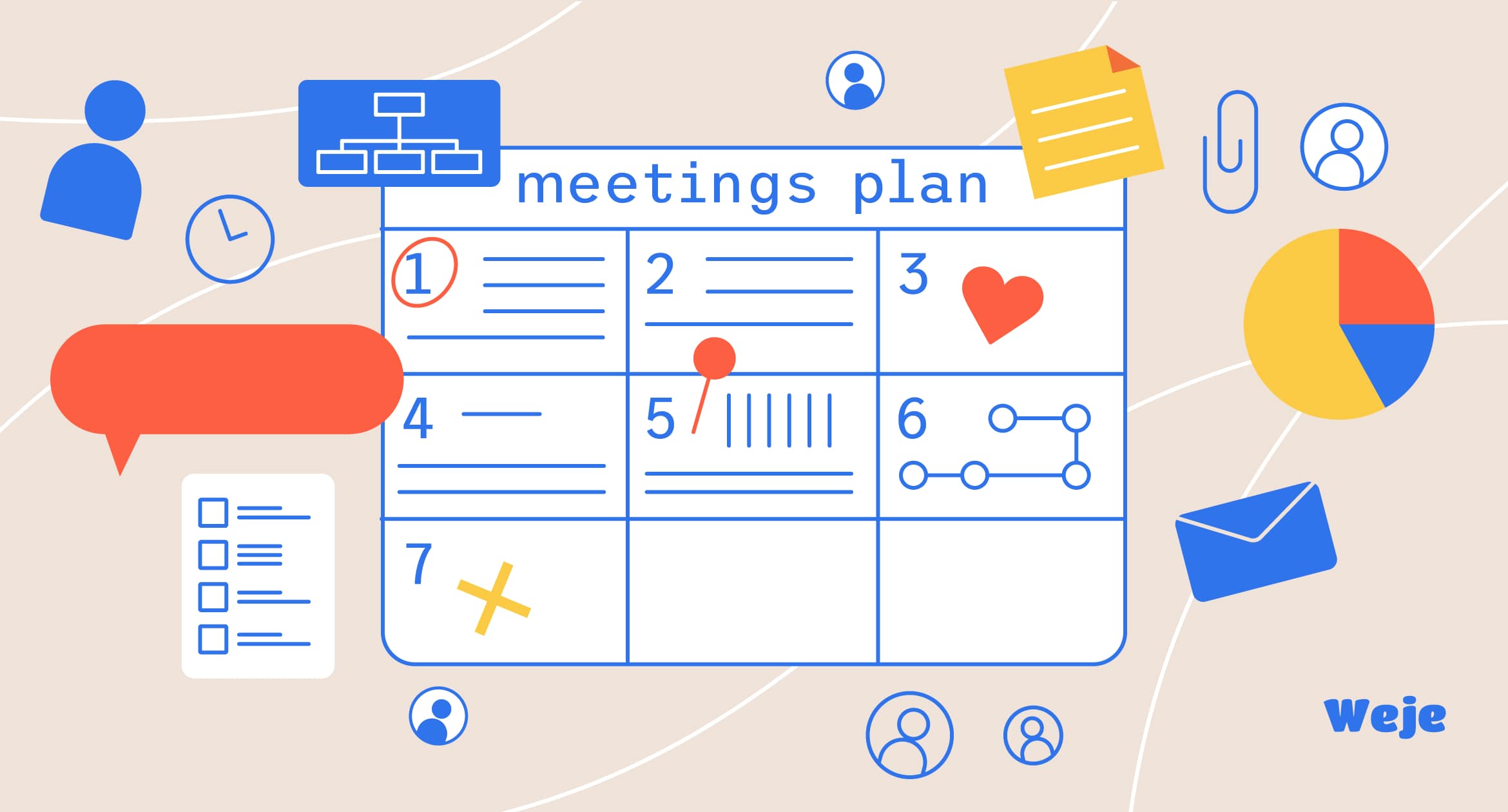Have you ever tried holding staff meetings? If yes, then at the end of the event you came across such statements as “Again we talked about nothing”. This is a classic situation, and it is associated with not knowing how to conduct planning meetings, and not with the fact that it is generally bad and ineffective. And in order to immediately place all the points, let’s fix the very concept of what a planning meeting is.
A planning meeting is a short meeting to assess and determine the progress of the assigned tasks. The key word is a short meeting. This is what makes a planning meeting different from a meeting. And since everything is relative in the world, we will determine the maximum limit for how long such a meeting lasts is 60 minutes. Everything else is not a planning meeting but like an ordinary meeting.
Types of meetings
At first glance, weekly staff meeting agendas are all the same, but in reality, their structures and goals are different. Therefore, you need to know their types and use exactly the ones that your team needs.
1. Time spending
We can divide all planning meetings into three times: daily, weekly and monthly. Usually, the company has only one of these options, all others are considered unnecessary. Although they all carry different tasks and are carried out according to a different plan.
- Daily meeting. Needed in case of vigorous activity or motivation of employees. Its duration does not exceed 15 minutes, everything is short and to the point;
- Weekly meeting. It is for summarizing the past week and making plans for the future. The duration of such a meeting is up to 30 minutes;
- Monthly meeting. An obligatory event for assessing the results obtained for a month of work, which has developed from all days and weeks. Duration up to 1 hour. Often the monthly meeting is extended to 2-3 hours.
2. Topic of the meeting
In addition to the fact that the planning meetings are divided into time intervals, they are also divided into topics.
Although for the majority, a planning meeting is an assessment of completed tasks in a week and a summing up of the results of achieving the sales plan. There is also such a format, but everything is gradual.
- Distribution of tasks. The goal and result of such a meeting is that employees are overwhelmed with tasks for the near future;
- One question. Most often these are unscheduled meetings, the topic for which is separate issues on the agenda;
- Informational. The same planning meeting that we are all so used to, voicing the actual situation at a given moment in time;
- Motivational. People need to be energized, especially if they have a very stressful job. Through such meetings, you will have the opportunity to do this, because this is an excellent method of motivation;
- Educational. Little knowledge in a short period of time. This will not get boring and will be useful, especially if you do it often.
In reality, team meetings agenda planning are like a snowball of different topics. It’s not bad. The main thing is to be able to pay enough attention to everything.
Components of a successful meeting
Before we move on to specific templates for a planning meeting, let’s define the main points of such a meeting. Because it is important not only WHAT, but also HOW to carry out. Everything gradually colleagues, take your time.
- The reason for the meeting. With this we figured out, every meeting should have a reason. And everyone should know about it;
- People. You must know in advance who will participate in the planning meeting and notify the participants about it;
- Location. Conference room, office or lunch in a cafe — decide for yourself. I’m sure it’s not difficult;
- Time spending. It takes a specific time, preferably always the same, in order to develop a habit;
- Meeting schedule. You and your staff should be aware of the subtopics and timing of the meeting;
- Curator. Usually the leader of the planning meeting is the boss or one of the leaders, but it may well be an employee;
- Secretary. The person who will record all the results of the planning meeting, the so-called protocol, for further distribution.
If you take these components into account, then the effectiveness of the meeting will be much higher, because you will be able to properly prepare for it and you will know exactly what to say at the meeting.
Systematic monthly planning meetings, weekly staff meetings and daily fly-ins are the most important tools for the development of the sales department and the organization as a whole.
Rules of a successful meeting
No secret recipes exist here. There is a set of ground rules to help you get the most out of your meeting.
1. Don’t make the meeting one-sided
If the meeting, instead of discussing work issues and usefulness, turns, for example, into a public flogging of the guilty or a monologue of the leader, there will be little sense. You need to build the meeting in such a way as to work out as many different issues as possible. Break the meeting into parts:
- Announcement of the meeting plan. First, list the list of agenda items. Quite briefly – the details will begin during the discussion of the issues themselves.
- Run through the past meeting. What tasks were set, how they are being fulfilled, what difficulties arise.
- Start the discussion with important and urgent tasks, gradually moving down to less significant ones.
- Ask the audience to ask questions. Sometimes this is the only chance for them to do it. Perhaps not all can see each other outside your office, but here, while everyone is gathered, you need to use the opportunity.
- End the meeting. In the end, as we have already said, you can discuss issues that do not directly concern business: life outside the office, employee birthdays, and so on.
2. Don’t turn RAM into a set of formalities
Keep the meeting as simple as possible. Avoid protocol and excessive formalities. If you choose a secretary for half an hour, read out the weekly staff meeting agenda and vote for it, keep a detailed protocol and all that, then by the middle of the operative you will hear a friendly snoring. Don’t waste time and get started right away. Leave the formalities to the meetings of the city council and the congresses of the trade union committee.
3. Praise your subordinates
During the meeting, remember to tag those who did a good job. It motivates people to work better — this time. A person sees that his merits have not gone unnoticed – these are two. And for others, a good example.
4. Make lyrical digressions
If the meeting lasts more than half an hour, it makes sense to get distracted a couple of times along the way. Think of lectures at university or lessons at school. If the teacher writes integrals on the blackboard for 45 minutes without stopping, such a lesson becomes boring and uninteresting. But as soon as he tells a story from life or just makes a couple of jokes, the lecture turns out to be fascinating and exciting. People go to such classes more willingly, and even the most difficult material is absorbed better.
Pay attention to
- The date of the meeting. Looking at the document, employees should understand when the meeting took place and can navigate the deadlines. Better yet, let the daddies start and keep all the protocols in them. It can be done electronically.
- List of tasks. The most important point. All instructions must be formulated clearly and, most importantly, unambiguously. Remember, an order that can be misunderstood will be misunderstood.
- List of responsible persons. It is better to draw up a protocol in the form of a plate, where the surname or surnames of the employees responsible for their implementation will be indicated opposite each task.
- Deadline for the task. In the same table, opposite the employee’s surname, indicate the date when the order must be completed. Never put a deadline. If a month is given to complete the work, indicate 3 weeks in the protocol. So you discipline the employee and leave yourself and him time to maneuver.
A meeting is a very effective communication tool when used correctly. Make it a system and very soon you will feel the result.
Published: March 15, 2021




